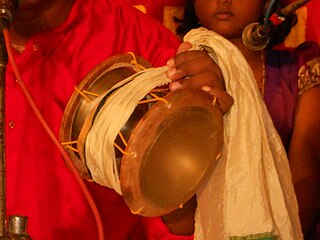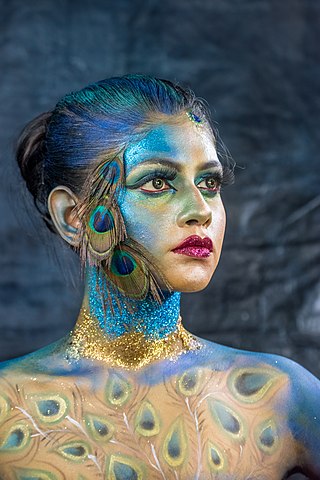
The Tamil people, also known as Tamilar, Tamilians, or simply Tamils, are a Dravidian ethnolinguistic group who natively speak the Tamil language and trace their ancestry mainly to India's southern state of Tamil Nadu, the union territory of Puducherry, and to Sri Lanka. The Tamil language is one of the world's longest-surviving classical languages, with over 2000 years of Tamil literature, including the Sangam poems, which were composed between 300 BCE and 300 CE. People who speak Tamil as their mother tongue and are born in Tamil clans are considered Tamils.
Arts and architecture in India have had their course shaped by a synthesis of indigenous and foreign influences that have consequently shaped the course of the arts of the rest of Asia, since ancient times. Arts refer to paintings, architecture, literature, music, dance, languages and cinema. In early India, most of the arts were derived Vedic influences. After the birth of contemporary Hinduism, Jainism, Buddhism, and Sikhism arts flourished under the patronage of kings and emperors. The coming of Islam spawned a whole new era of Indian architecture and art. Finally the British brought their own Gothic and Roman influences and fused it with the Indian style. They have a culture infusion in their art.

Dance in India comprises numerous styles of dances, generally classified as classical or folk. As with other aspects of Indian culture, different forms of dances originated in different parts of India, developed according to the local traditions and also imbibed elements from other parts of the country.
Marthandam is a major trade centre in Kuzhithurai municipality across National Highway in the Kanyakumari district of Tamil Nadu, India. Formerly known as Thoduvetty, it was a portion of Kanyakumari district which was added to the state of Tamil Nadu on 1 November 1956.

Koothu or Therukoothu (jwalith), is an ancient art, where artists play songs with dance and music in storytelling the epics, performed in Tamil; it is a folk art originated from the early Tamil country. More precisely Koothu refers to either Terukuttu (Tamil:தெருக்கூத்து) or Kattaikkuttu. The terms Terukkuttu and Kattaikkuttu are often used interchangeably in modern times; however, historically, the two terms appear to have distinguished, at least in certain villages, between two different kinds of performance: while Terukkuttu referred to mobile performances in a procession, Kattaikkuttu denotes overnight, narrative performances at a fixed performance space. Koothu as a form of entertainment reached its peak hundreds of years ago in Tamil Nadu, as mentioned in the Sangam texts about the development of iyal (literature), isai (music) and natagam (drama). Going beyond just a means of entertainment, koothu educates the rural people about religion and their history.

The culture of Kerala has developed over the past millennia, influences from other parts of India and abroad. It is defined by its antiquity and the organic continuity sustained by the Malayali people. Modern Kerala society took shape owing to migrations from different parts of India and abroad throughout Classical Antiquity.

Puli kali is a recreational folk art from the state of Kerala, India. It is performed by trained artists to entertain people on the occasion of Onam, an annual harvest festival, celebrated mainly in the Indian state of Kerala. On the fourth day of Onam celebrations, performers painted like tigers and leopards in bright yellow, red, and black shake their bellies and dance to the beats of instruments like Udukku and Thakil. The literal meaning of Pulikkali is 'The tiger dance' hence the performance revolves around the theme of tiger hunting. Folk art is mainly practiced in the Thrissur district of Kerala. The best place to watch the show is at Thrissur on the fourth day of Onam, where Pulikkali troupes from all over the district assemble to display their skills. The festival attracts thousands of people to the Thrissur city. Pulikkali is also performed during various other festive seasons.

Kanniyar Kali is a folk dance ritual performed in Temples of villages in Alathur and Chittur Taluk of Palakkad district of Kerala. The event is usually a part of Vishu celebrations of the village and usually succeeds the Vela and is usually performed during the months of April and May. It is an agricultural festival dance of Nair community. Kanniyar Kali, despite the name of the Virgin, does not have anything to do with the Kannaki cult.

The udukkai, udukai or udukku is a member of the family of membranophone percussion instruments of India and Nepal used in folk music and prayers in Tamil Nadu. The drums are an ancient design of hourglass drums similar to the northern damaru and southern idakka. Its shape is similar to other Indian hourglass drums, having a small snare stretched over one side. They are played with the bare hand, and the pitch may be tered by squeezing the lacing in the middle. It is made of wood or brass and is very portable. It originated in Tamil Nadu as well. Other members in the family include thehuruk, hurkî, hurko, hudko or hudka, utukkai.
Tamil Nadu has a rich history of art and entertainment. The three modes of entertainment classified as Iyel (Literature), Isai (Music) and Nadagam (Drama) had their roots in the rural folk theatre like Theru Koothu. Many forms of group and individual dances with the classical forms for popularity and sheer entertainment value. Some of the dance forms are performed by Tribal people. The majority of these dances are still thriving in Tamil Nadu today.
Tamil culture is the culture of the Tamil people. Tamil culture is rooted in the arts and ways of life of Tamils in India, Sri Lanka, Malaysia, Singapore, and across the globe. It has a long history of diversified heritage and cultural distinctions.
Theeyaattam also known as Theeyaattu (Tīyāttu) is a traditional temple dance form of Kerala.

Thiruvathira or Thiruvathirai or Arudhra Darisanam is a Hindu festival celebrated in the Indian states of Kerala and Tamil Nadu. Thiruvathirai (Arudhra) in Tamil means "sacred big wave". In Chidambaram in Tamil Nadu, the Nataraja Temple's annual festival is celebrated on this date. In the month of Makaram Thiruvathira Star is celebrated in Mathira Peedika Devi Temple, owned by Thiruvithamcore Devaswom Board, near Kadakkal in Kollam District of Kerala state.

Tiger dance is a traditional performing art in which persons wearing tiger costumes dance by themselves or with others.

The peacock dance or peafowl dance is a traditional Asian folk dance that describes the beauty and the movement of peacocks. There are several peacock dance traditions developed in Asia, among others are peacock dances of Myanmar, and in the western and northern parts of Cambodia, West Java in Indonesia, also peacock dances of Indian subcontinent in Southern India, Sri Lanka, and Bangladesh.

Poikkaal Kuthirai Aattam or Puravi Aattam is one of the folk dances of Tamil Nadu. It is a type of dance performed with a dummy horse having a gap inside so that a person can fit into it to perform the dance.

Vidya Iyer, better known by her stage name Vidya Vox, is an American YouTuber and singer. She was born in Chennai, Tamil Nadu, India and immigrated with her family to the United States of America at the age of eight. According to NBC News, her music is a mix of "Western pop, electronic dance music, Bollywood hits, and Indian classical music." Since beginning her channel in April 2015, her videos have received over 906 million views, and her channel has accumulated over 7 million subscribers.
The National List of Intangible Cultural Heritage (ICH) of India is an attempt to recognize the diversity of Indian culture embedded in its intangible heritage. It aims to raise awareness about the various intangible cultural heritage elements from different states of India at national and international level and ensure their protection.












